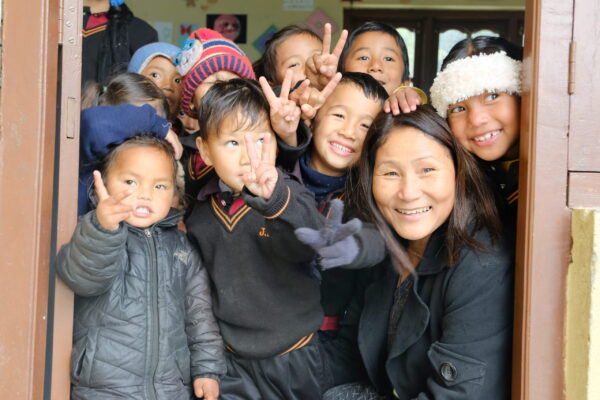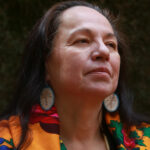This article was originally published in Indian Country Today, with the support of CRCC’s global project on engaged spirituality.
Our aunties are the same all over the world. They are the “go to” women who get things done. They are unafraid to march into the tribal or government office, they take us by the hand, and walk with us as we face problems and barriers. They offer emotional and physical support as well as encouragement.
In the kingdom of Nepal, aunties are called ‘didi’ for older sister or ama ‘mother.’
Although they may have no official title, everyone knows them.
Indira Ranamagar of the Magar tribe is the founder and director of Prisoners’ Assistance Nepal or PA Nepal, a non-profit charitable organization helping incarcerated women and children.
In the remote district of Jhapa in far eastern Nepal, she is known simply as “Ama.”
Ranamagar is a reliable advocate, not only for prisoners and their children, but also for Indigenous women and their families. Indigenous women face disparities in wealth, power and health. Dispossessed from their traditional lands, they experience higher rates of violence, generational poverty, illiteracy and incarceration compared with members of Nepal’s ruling Hindu castes. Indigenous women comprise about 18 percent of the population.
I traveled to the kingdom of Nepal just before the pandemic hit this year. The country is a little more than twice the size of the Navajo Nation, squeezed between massive Indian and China. I was there to interview Ranamagar as part of a fellowship called “Spiritual Exemplars” with the University of Southern California Center for Religion and Civic Culture. Ostensibly, the goals of the project are to identify how spirituality informs the work of people working on humanitarian causes.
Watch Mary Annette Pember talk about her story on the Indian Country Today Newscast
(Starts at 19:50 on the video)
The interview questions were generated by Western educated academics from the center and reflected a distinctly non-Indigenous worldview in which spirituality is viewed as a concept apart from daily life. Dutifully, I asked Ranamagar the questions about “cultural context,” and “faith traditions” during our initial interview. She stared at me with a blank expression on her face that told me what I already knew. Spirituality is too deeply embedded in the lives of Indigenous peoples to be teased out by such blunt questions. In order to know her and begin to tell her story, I’d need to immerse myself in her world and work.
And so for several days, I travel with Ama through the overflowing city prison of Kathmandu to the tiny jails of Jhapa district where the women prisoners and their children sleep chock-a-block on the concrete floor of one cell. We visit her schools for prisoners’ children, the various little communities of untouchables and landless Indigenous people squatting on patches of ground within great tea estates for whom she offers support and all the others who come to her, Ama, for help.
“For me, my work is my power; and I have always worked fiercely,” Ranamagar says. The belief that everyone, regardless of caste, gender or ethnicity deserves dignity, safety, love access to healthy food, water and education are fundamental parts of her DNA. That belief is her religion, and the work is her prayer.
Ranamagar grew up in poverty in a village where girls didn’t go to school.
Initially her brother showed her how to read and write by drawing letters in the dirt with a stick. Desperate for education, she finally convinced her parents to allow her to attend school. Eventually she came to know the work of Parijat, a well-known Nepali poet and activist for gender and social justice. A citizen of the Tamang tribe, Parijat inspired Ranamagar to study social work and work for women’s and prisoner’s rights.
Ranamagar personally visits as many of Nepal’s 74 prisons as possible. According to the Nepali Times, there are 24, 512 prisoners in the country’s jails; 1,528 are women.
Most of the women in Nepal’s prisons are poor and illiterate. Many are Indigenous and others may be members of untouchable castes.
“They are convicted of low level property crimes or for sex or drug trafficking, essentially for trying to provide food and the basics for their families. I think of them as survivors rather than criminals” she says.
The Hindu caste system is an ancient hierarchical social system assigned to Hindus at birth. Although officially outlawed in Nepal and India, the caste system still informs many aspects of life. Low caste people, often referred to collectively as Dalits, continue to be marginalized socially and economically.
There is little funding for prisons in Nepal, one of the world’s 30 poorest and least developed in the world. There is virtually no public support for prison reform or prisoner’s rights, especially for women. A Hindu majority country, Nepal still supports the caste system that is particularly repressive for women, according to UN Women, Asia and the Pacific.
Incarcerated women are often forced to keep their children with them if they have no outside family help.
There is no minimum, medium nor high security levels dividing violent perpetrators from petty criminals in Nepal’s jails. Murderers and shoplifters, career criminals and first-time offenders are all housed together. The government supplies each prisoner with a daily food allowance of 750 grams of rice and 60 Nepali Rupees (NRs) per day and an additional 35 NRs for children. One pound of rice costs approximately 44.43 NRs.
Fresh food is scant, and there is little to do in the jails.
In addition to helping prisoners with basic food and hygiene needs, Ranamagar and her colleagues and donors with PA Nepal offer daycare and schooling for children of prisoners, adult literacy programs and support for newly released prisoners. In some cases, children go to daycare or school outside of the prison but return to jail in the evenings. PA Nepal also operates 16 homes for children of prisoners where children can live and go to school outside of the prisons. Additionally, the organization runs a program called Firefly Primary Schools offering long-term supportive schooling for children of prisoners who have been released.
“There is so much stigma associated with prison, both for women and their children,” Ranamagar says. “We want to reduce that and help train them for good lives after prison.”
Nepal, modern yet medieval
I lived in Nepal more than 20 years ago. Watching Ranamagar make her rounds to prisons and villages took me back to those days. On the surface, so much about the country has changed. Kathmandu and its medieval warren of dirt streets have nearly all been paved. The roads are now thick with motorcycles and cars creating a sort of impenetrable ocean of vehicles and exhaust; crossing the street feels like a death wish. Kathmandu is one of the fastest growing cities in southeast Asia.
But the Nepal of my youth is still there, just hidden. The warm human jumble of the sacred and the profane still permeate the streets. Taxi drivers still work on their cars jacked up in the courtyard of ancient temples while the faithful conduct delicate pujas, prayer rituals, to the local spirits.
And spending time with Nepalis still feels like visiting tribal nations where a thousand of your cousins live within a few square miles.
Ranamagar showed me one of the prisons she serves in Jhapa district, about a 10-hour drive east of Kathmandu along narrow twisting mountain roads and through hundreds of small farming communities. Jhapa, a farming district located in the Terai, a tropical lowland, is also where Ranamagar was born.
We arrive in her tiny village late at night where her relatives guide our jeep down a dark narrow dirt road. Exhausted, I immediately fall asleep on the hard Nepali bed that also functions as a couch in the cramped living room/bedroom/main room of the little farm house. I wake briefly a couple of hours later to find myself serving as a backrest for several family members as they watch a popular Nepali television serial. I imagine they are my cousins and fall asleep again with the comforting vision of their faces bathed in the reflected light from the television.
Awakened early by a roosters call, I explore the area and find a little neighborhood tucked away from the village. A group of Dalits made their home along the banks of a small pond. I stumble upon their morning routine. Mothers bath and dress their children and cook breakfast outdoors on wood fires in front of their handmade mud homes.
Residents tell me that Ranamagar purchased the little plot of land for them so the landless group could live here unmolested. She has several such side projects, buying food and clothing, helping with school fees, purchasing bits of land for those in need.
The protocol for visiting a prison is almost as complex as getting out.
Corruption, nepotism and graft are deeply embedded in government service, agencies are famous for their lack of transparency. Ranamagar skillfully navigates the complex landscape of prison leadership with a delicate combination of deference and determination. At last, the warden allows us inside and even consents to a short interview.
The jailer uses a huge key to open the main gate made of thick metal bars reminiscent of the jail cells featured in old-time American westerns.
The gate slams shut with a disturbingly final clang.
Once inside, women and children eagerly gather around Ranamagar as she distributes food, clothing, books, craft materials, affection and words of encouragement. Children, some in diapers wander around the small open courtyard where the prisoners spend most of their days. Laundry dries on lines crisscrossing the yard, women squat near little cooking fires preparing food.
At night, prisoners and their children sleep tightly packed together on mats placed on the cement floor of one small cell. During the day, they roll up the mats; if the weather is good, they gather outside in the courtyard. If the weather is bad, they sit in the sleeping cell. Without programming or education services, there is little for the women to do.
Bena Shrestha, however, eagerly agrees to an interview. Seated on a low chair in the courtyard, she describes her 11-year-old son Shiva’s life at Ranamagar’s local school for prisoner’s children.
“I’m so proud of Shiva,” she says. “He lives at PA Nepal’s Children’s home and goes to school.”
Previously, Shiva lived full time within the prison’s walls with his mother without access to education.
Shrestha has 5 years left of an 11-year sentence for selling drugs. Although she misses her son, she’s happy he is leading a normal life and going to school. It bodes well for the family’s future, according to Shrestha.
“I get to speak with him by phone at least once a week,” she says.
Shrestha, however, is a rare example of good fortune for most of Nepal’s female prisoners.
Most Nepalis favor punitive measures for prisoners rather than reform, according to Rajendra Niraula, head jailer at Jhapa District Jail.
“I felt the same way before my work here; I’ve come to see that the prisoners are human beings entitled to the same human rights afforded to others,” he says.
Jhapa District Jail houses 1170 prisoners; 100 are women with 5 children living with them. The prison’s official capacity is 350, according to Niraula.
“The government underfunds and neglects prisons in Nepal. Other than voluntary organizations such as PA Nepal, there is no resource for our inmates,” he says.
Without training or education, recidivism is high, according to Niraula.
Prisoners and their children languish in crowded cells that are hotbeds for infectious diseases such as tuberculosis, typhoid and influenza, according to an article in the Nepaltimes. The COVID-19 outbreak has strained the already untenable life inside Nepal’s prisons.
Currently, prisons are closed to visitors as authorities scramble to provide protection for prisoners and workers and maintain some measure of social distancing.
About 400 inmates have been released since the Office of Attorney General recommended early release of vulnerable and non-violent inmates as a means to stem the spread of the virus. But according to Ranamagar, the effort isn’t nearly enough.
Journalists and advocates such as Ranamagar complain that the government is using the virus as a means to avoid transparency and accountability.
“Although we can no longer visit the inmates, we drop off food, masks, hygiene supplies, clothing and education materials for them,” Ranamagar says.
During COVID-19 lockdowns and restrictions, inmates’ children remain housed in PA Nepal children’s homes; it’s unclear, however, if or when classes will resume. Since Ranamagar can no longer personally check on jail conditions, she depends on staff to deliver food and supplies to jails outside of Kathmandu.
There is no information on the number of COVID-19 infections or deaths in the country’s prisons.
The Nepali government enforced a lockdown from March 24 to July 21, resulting in a steep decline in COVID-19 cases and deaths. Since its partial reopening, however, the official number of cases has grown substantially. According to the Himalayan Times, the Nepali Health Ministry reported the number of COVID-19 cases has reached 19,119 with a death toll of 164.
As numbers rise, the government is considering another lockdown, including restrictions on international flights. Heavily dependent of foreign tourism, lockdowns stop the earnings of tens of thousands of daily wage earners.
Ranamagar, however, soldiers on. Now she begins each day by cooking for the hundreds of newly homeless people in Kathmandu, thrown out of work by the virus.
In early March, she began posting videos to her Facebook page of her daily cooking operation. The few small pots on her stove have gradually expanded to enormous vats of rice and lentils prepared on portable cookers on the kitchen floor. Rather than cooking spoons, she stirs the food with large wooden paddles.
Ranamagar and a friend move quickly as they bring food to the hungry.
She publishes videos of her meal distribution work on her Facebook page.
“People know our car and come when they see us. Sometimes the police try to shoo us away; they complain I’m encouraging crowds to gather (in violation of government restrictions) but people have no work, no homes, they are starving,” she says.
“In some ways, this virus has presented more challenges than the 2015 earthquake; at that time people were unified and supported each other,” Ranamagar says.
“But in the time of COVID-19, people are allowing fear to overwhelm their humanity; there seems to be no place in their hearts for the poor,” she says.
Lately, the banking system has been holding up international donations to PA Nepal, according to Ranamagar. She depends on local friends for donations of food to feed the hungry, saying, “I have to fulfill our mission of helping those in need; work remains my power.”
Read the article on indiancountrytoday.com.
Mary Annette Pember is a journalist fellow with the Spiritual Exemplars Project.












